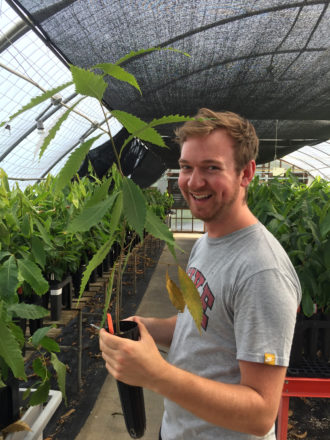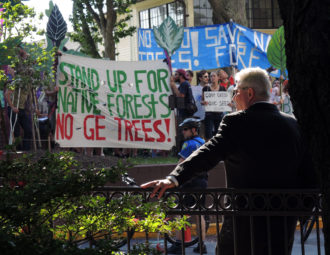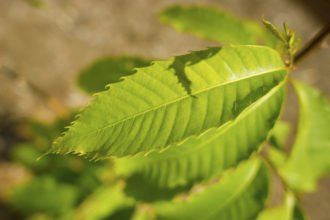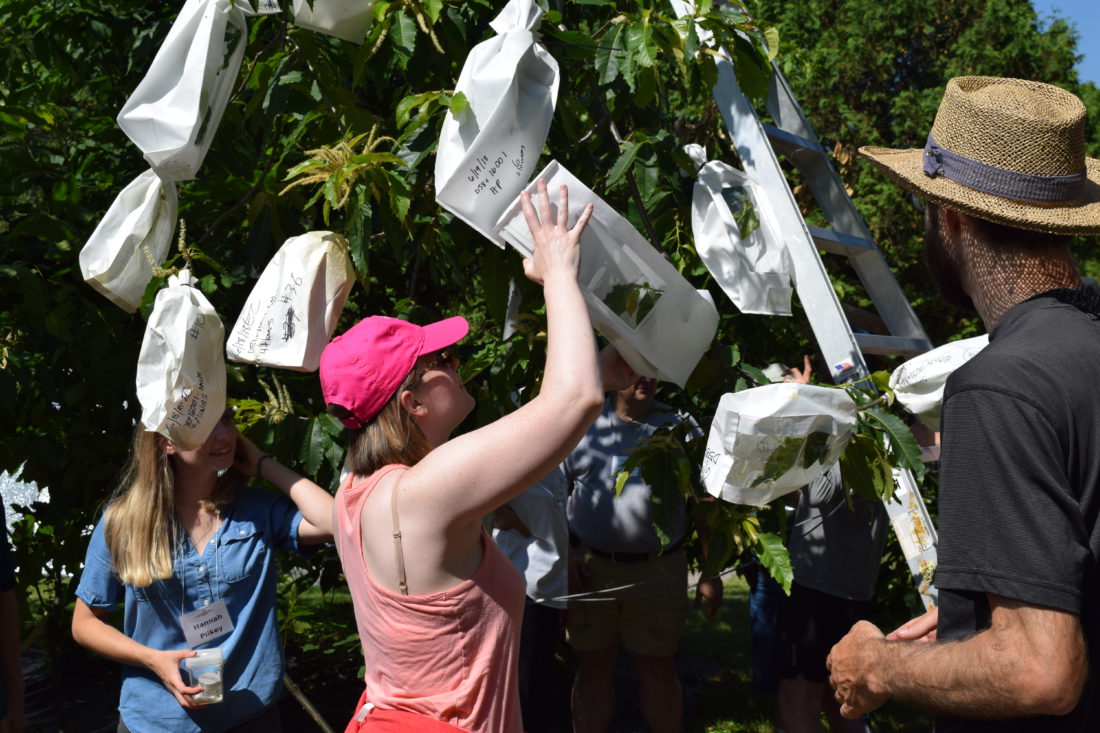No one ever said it would be simple. When The American Chestnut Foundation was established in 1983, the Asheville-based organization set the lofty goal of restoring the iconic species on the nearly 200 million forest acres of its native range in the eastern U.S. At the turn of the 20th century, approximately 4 billion chestnut trees blanketed the region, providing invaluable food, lumber and wildlife habitat — until the accidental introduction of the chestnut blight rendered the native species functionally extinct.
Although the blight, a parasitic fungus that hitchhiked to America on imported Asian chestnut trees, doesn’t kill the roots, the new growth that still sprouts from old stumps soon succumbs to the disease. And though some naturally blight-tolerant trees still exist in the wild, most are outside the American chestnut’s original range, and reestablishing the tree here has proved extremely difficult.
For more than 35 years, the foundation has been trying to develop a hybrid that can fight back against the blight and enable the tree to reclaim its dominant place in the regional forest ecosystem. Foundation researchers have tried crossbreeding the native strain with the Chinese chestnut to produce a hybrid that would have both the desirable qualities of the American chestnut and the Chinese tree’s blight tolerance.
Once that was achieved, the plan was to backcross those hybrids with pure American chestnuts, says Jared Westbrook, the foundation’s director of science. Over multiple generations, he explains, the program was expected to yield seedlings that grew tall and straight like their American cousins — the smaller, bushier Chinese chestnut is less timber-friendly — but also contained the Asian genes responsible for withstanding the blight. The results of small-scale field plantings in national forests, however, have shown that this is easier said than done.
“There is this trade-off between how blight-tolerant our backcross trees are and how American they are,” says Westbrook. “As you do backcrossing, you get hybrids that are progressively more American in their genome inheritance, and we found that those trees get less and less blight-tolerant as we go down the generations in making the trees more American.”
This realization has led the foundation to reconsider its approach. The organization is now placing more of its hopes on a new strategy to battle the blight: using genetic engineering to transfer a wheat gene to the American chestnut. If federal regulators sign off on the GE trees, the foundation could use them freely both in its managed orchards and in actual forest settings. That could happen as early as next year, says William Powell, a professor of environmental and forest biology at The State University of New York who is leading the research effort.
“The result with the breeding program has underscored that we need to be looking for alternative ways that we can get blight-tolerant trees,” says Westbrook. “To me, that’s made it more urgent to embrace the use of transgenic technology.”
Transgenic tools
In fact, a GE chestnut has been under development since 1990, when the foundation’s New York chapter began partnering with Powell. He and his colleagues found that American chestnuts containing the oxalate oxidase, or OxO, gene from wheat could break down the main toxin produced by the blight fungus and thus remain healthy.

These trees display strong blight tolerance while remaining over 99.99% genetically American chestnut. In comparison, some of the most blight-tolerant trees produced through hybridization and backcrossing are only 70% American, says Ben Jarrett, the foundation’s Southern regional science coordinator.
That’s because the recently completed sequencing and comparison of the genomes of Chinese and American trees showed that blight tolerance in the Chinese chestnut involves at least nine genes, not two or three, as foundation scientists had previously believed. “Our backcross breeding program that we initially thought was pretty genetically simple is actually a lot more genetically complex,” Jarrett explains.
Bringing the GE tree into the program would give researchers a much more direct route to achieving their goal. “The backcross program and the transgenic program have been pretty parallel, but in the future, we will likely be crossing those two programs together,” he says.
Westbrook, meanwhile, emphasizes that incorporating a GE tree won’t mean the end of his organization’s traditional breeding work. As of now, only one transgenic “event” — a specific insertion of the OxO gene into a single type of chestnut — is under review by the U.S. Department of Agriculture, the Environmental Protection Agency and the Food and Drug Administration. Once all three agencies sign off on the procedure, scientists would then need to cross that tree with other strains received from the foundation’s 16 state chapters to prevent inbreeding.
“It’s going to be like a Genghis Khan situation, where you have one dad and many different moms,” says Westbrook. Multiple generations of breeding, he explains, would be needed to distribute the OxO gene throughout the breeding pool, which includes American chestnuts adapted to local environments as different as Alabama and Maine.
GM-no?
Not everyone with a stake in the restoration program is on board with the foundation’s embrace of transgenic trees, however. Two board members from the Massachusetts/Rhode Island chapter, Lois Breault-Melican and Denis Melican, resigned from the organization in March, citing the “unknown, long-term risks posed by the GE chestnut” in a statement published by the Global Justice Ecology Project.

In April, the project released a white paper arguing against the approval of transgenic chestnuts. Executive Director Anne Petermann says the history of such GE crops as Monsanto’s Roundup Ready corn and soy has been marked by inadvertent negative impacts on both the environment and human health. The transgenic American chestnut, with its potential life span of well over a century, could create unforeseen problems for years to come, she points out.
“Crop plants only live a year, and then you have to replant them. They’re a little bit under control that way,” notes Petermann. “There’s no way to know what that genetic manipulation is going to do over time. These trees are subject to all kinds of environmental pressures, from droughts to heat waves to cold snaps to insect infestations, that cause the genetics of the tree to change in response.”
Jarrett, however, roundly rejects those claims, calling both the specific genetic engineering process used and the OxO gene “pretty fail-safe.” In short-term studies with bumblebees, tadpoles, caterpillars and native plant seeds, the transgenic tree’s interactions have been functionally identical to those of wild trees, he says, and humans have been consuming the OxO gene in wheat for thousands of years with no apparent negative health effects.
Others have expressed broader philosophical objections to the use of transgenic technology. BJ McManama, Save Our Roots campaign organizer for the Indigenous Environmental Network and a longtime collaborator with the Eastern Band of Cherokee Indians, says GE trees represent “basic human hubris” around the transformation of the natural world.
“In a lot of ways, we’re violating our Original Instructions by forcing unrelated DNA to work together,” McManama argues, referencing a term for the indigenous relationship to nature. “There’s a reason we don’t have cat-dogs or squirrel-deer.”
Petermann also points to funding the GE chestnut effort has received from ArborGen, a company that’s developing transgenic eucalyptus and loblolly pine, and from the Duke Energy-supported Forest Health Initiative. She believes the chestnut is a “Trojan horse” for economically motivated transgenics; if these companies “win over the public through this supposedly altruistic application,” she maintains, “then they’ll be able to get their commercial GE trees through the door.”
Westbrook dismisses that theory as “completely bogus. Most of our funding comes from individual donors and private foundations that are interested in the chestnut. The people that I actually collaborate with are scientists that are just genuinely interested in seeing this tree back.”
Enter root rot
For now, GE chestnut plantings are restricted to a single USDA-approved site: a research station in Syracuse, N.Y. But foundation chapters across the region — including the Carolinas chapter, which operates a chestnut conservation orchard at the Cataloochee Ranch in Maggie Valley — are being asked to prepare for the next stage of the effort in case the tree receives federal approval.
“We support what [the foundation] is proposing and planning going forward,” says Doug Gillis, president of the local chapter. “I have not heard anyone on the Carolinas [board of directors] expressing concern about the process of backcross breeding or the work we’re doing in terms of looking at the transgenic tree.”
Gillis says the Cataloochee orchard is preserving specimens of surviving wild American chestnuts that might be crossed with the transgenic tree to help diversify the population. He also notes that his chapter sent branches from root rot-resistant hybrid chestnuts to the transgenic project in New York for experimental use. This disease has also contributed to many tree deaths in the South.
Warren Wilson College in Swannanoa hosts another of the Carolinas chapter’s orchards. Forest Manager Shawn Swartz oversees some 250 seedlings that he and his students helped the foundation evaluate for root rot resistance at the Bent Creek Resistance Screening Center and planted on campus. Swartz says the college hasn’t discussed working with transgenic material but doubts the Swannanoa site would even be considered for such plantings.
The college’s orchard, he explains, contains the highest levels of root rot-causing Phytophthora water mold found at any of the foundation’s many research sites. The current version of the transgenic American chestnut tree hasn’t yet been evaluated for resistance to that disease.
“These trees are not going to be cheap, and I’m imagining they’re going to put them in places where, at least initially, they’ll be able to succeed,” says Swartz. “Even if we were begging for it, we may not be a candidate.”
Seeds of change

Nonetheless, Swartz says he personally supports the foundation’s adoption of the transgenic American chestnut. Although he has both scientific and philosophical concerns about genetic modification in general, Swartz believes the GE tree represents an honest effort to repair the ecological damage caused when humans inadvertently introduced the chestnut blight by importing infected Asian trees.
Even with the help of transgenic techniques, he continues, the restoration project looks likely to be an uphill climb. Climate disruption and other factors, he points out, are constantly changing the forest environment, creating conditions that the tree never faced in its turn-of-the-century heyday.
Today, Swartz explains, “It’s a completely different system. The species have shifted as a result of the void the chestnut left, plus industrial logging, plus fire, and now we have climate change. … There are a lot of moving targets.”
Westbrook, meanwhile, acknowledges, “It’s never been done before, so this is a grand experiment.” It remains to be seen, he concedes, both how readily the public will accept the use of genetic engineering in the restoration effort and how well the blight-tolerant trees will perform in the wild.
In the meantime, stresses Westbrook, those unknowns are spurring the foundation to work even harder, using every tool at its disposal. “A lot of the members are pragmatic when it comes to chestnut restoration,” he says. “If there is a method that works and seems safe, they are all on board for using it.”



Follow the money: Monsanto (Bayer), ArborGen, Duke Energy want fast growing monocultures of genetically engineered poplar, pine and eucalyptus that will threaten our forests, our planet. Burning wood for fuel is classified as renewable energy. If the American Chestnut tree is approved by the USDA to release into the wild it opens the floodgate for all GE TREES! So they are starting here by pulling on the heartstring of the public who love the chestnut. The article failed to mention the first distribution of these trees, if they become legal , is at Mayland Community College in Spruce Pine.
As the article stated, this is a HUGE experiment , one that I feel is not worth the risk to our already compromised, delicate ecosystem. Lets leave mother nature to her own intelligence . If you listen to the sound of her forest you hear life. I have listened to a monoculture of trees: only silence and no bees or butterflies. If GE fruits and vegetables irritate your digestive system, I can assure you a GE Tree will irritate our forests.
The omission of Monsanto’s over a half million dollars of investment in this project is telling and the percentage difference between private donations and corporate funding is significant.
While SUNY ESF and TACF paint themselves as a not-for-profit that is no influenced by corporate interests, the project receives funding from corporations and institutions with vested interest in advancing public acceptance for GE trees and biotechnology generally.
These entities, which include a raft of multinations; Monsanto (now owned by Bayer), Duke Energy and biotech tree company ArborGen, provided SUNY-ESF with 40.21% of their GE American chestnut research funding between 2008 and 2017. In contrast, only 3.05% came from the general public – this information is directly from William Powell’s latest posted SUNY-ESF annual report (2008-2017).
Willam Powell, leading GE American chestnut researcher at SUNY-ESF, admits the tree’s useful PR role. About the planting of a GE American chestnut tree in the NY Botanical Garden, he stated, “The NY Botanical Garden test planting [of a GE American chestnut] is being established to meet several objectives… [including] incredible public education opportunities for SUNY-ESF’s American Chestnut Research and Restoration Project, The American Chestnut Foundation, and transgenic plants in general.”
ArborGen: In addition to GE tree company ArborGen providing $500,000 in financial support for SUNY-ESF American Chestnut Project between 2002-2013, as ArborGen’s Chief Technology Officer, Maud Hinchee worked closely with the Project research team to offer technical support. One of the SUNY-ESF lines of GE American chestnuts is called Hinchee 1.
In her role at ArborGen for more than 12 years where she led research programs to improve the genetic performance of “economically important forest tree species. Maud came to ArborGen after 18 years at Monsanto, where she had various leadership roles in the development and commercialization of transgenetic crops.” From Maud Hinchee’s LinkedIn Page. And all this is from Powell’s latest posted SUNY-ESF annual reports!
Monsanto provided both “in kind and monetary donations” to SUNY-ESF AND they are the co-founder of the biotech front group Forestry Biotechnology Initiative that later became ArborGen!
Both Monsanto/Bayer stand to benefit if the precedent-setting GE American chestnut tree is deregulated by USDA.
Readers can find more information along with the white paper that contains the information above at https://stopgetrees.org and at https://saveourroots.org
The preceding comment contains direct quotes presented by Anne Petermann, co-director of Global Justice Ecology Project, during the webinar/telepress event and can be viewed here: https://www.youtube.com/watch?v=kfP4cJ4J1do&authuser=0 – Anne, Rachel Smolker co-director of BioFuel Watch, Lois Mellican past official of the RI/MA TACF, Lorette Picano, Orin Langelle moderating, Steve Taylor assisting press with questions, and myself. Anne states clearly we aren’t “flat earthers” we aren’t into conspiracy theories or do we want to stop the amazing work that TACF has done over the last decades. At the end we all offer closing remarks and I give an example of how research has found that the citrus greening disease may very well be the cause of herbicide/pesticide overuse – here is the link to promising research and results in combating this devastating disease using nutrients the trees desperately need to heal themselves: https://www.gmwatch.org/en/news/latest-news/18803-expert-says-there-s-a-cure-for-citrus-greening-so-why-is-it-being-ignored
We humans need to learn to work WITH nature and not manipulate it to meet our wants. There is a LOT of money, billions being spent to genetically engineer forests and increase the use in food production. Consolidation of government and corporate power is on the rise fueled by greed/ego in an astounding display of hubris. Globalization was the cause of the fungus that killed the American chestnut and has brought non-native, invasive, and deadly organisms – plants, animals, fish, microbes, pests and pathogens to this country/continent that are now wreaking havoc on our environment and threatening the delicate biodiversity we all need to survive! (Kudzu anyone?) And combating one threat with another isn’t responsible in any reality-when we fundamentally change the DNA of a living entity, they no longer belong and are foreigners and potential threats to the balance of life.
Thanks much for adding your perspective, BJ. As far as I can tell, Monsanto itself did not directly donate any money to the project, although you are correct that the company is involved in funding The Consortium for Plant Biotechnology Research (which is not currently a funder). While ArborGen did provide $500,000 in the research’s early years, they are also not a current funder of the project according to the Powell’s most recently available report (https://www.esf.edu/efb/annualreports/1617/documents/Powell1617.pdf).
Those interested in assessing the raw data behind the funding for the GE chestnut can find all of Powell’s annual reports dating from fiscal 2008-09 here: https://www.esf.edu/efb/annualreports/
The American Chestnut Cooperators Foundation has worked many years to breed pure American Chestnut trees with blight resistance without the aid of Asian chestnut genes or genetic engineering. https://www.accf-online.org or
https://www.accf-chestnut.org/ Next task, Phytophthora resistance.